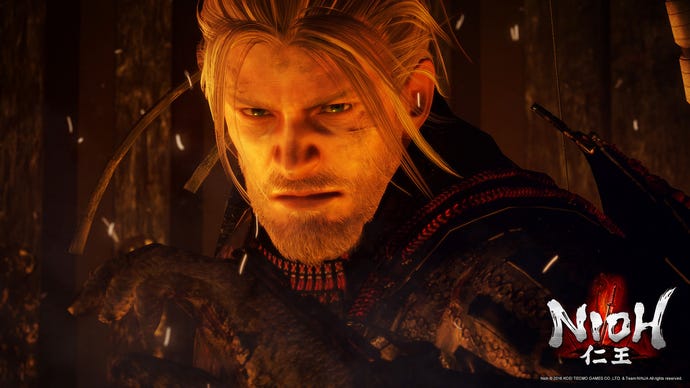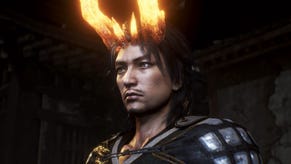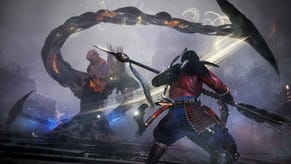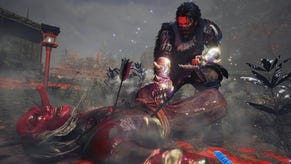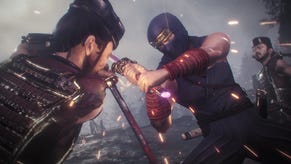Nioh tips: 16 things you didn't know you could do

Nioh guide: 16 things you didn't know you could do
At first glance, Nioh may appear to follow certain design mantras set forth by the Soulsborne series. Look closer, however, and you’ll find there’s more to this game than a Souls clone with samurai. If you try to play this just like Dark Souls, well - you'll struggle.
Nioh is a very dense and layered game, both in terms of environmental layout and intricate system design. There’s a number of mechanics that you won’t find in any other game, and Nioh itself doesn't bother to explain them to you. Luckily, that's where we come in. We’re going to cover some of the lesser-known tips and strategies we've discovered, as well as a few more advanced techniques to help you survive the latter levels.
If you’re just starting Nioh and you're after some advice for the early game, be sure to give our beginners tips list a look. If you think you’re beyond these, though, read on!
You can find out at a glance if you have enough Amrita to level up
Nioh’s smart UI design comes in handy in many situations, but there’s one subtle hint the UI gives you that you should be aware of.
The Amrita counter on the bottom right side of the screen will actually tell you if you have enough to level up. When the icon turns yellow, instead of the typical white, that means you can gain at least one level with the Amrita you have on you.
The game doesn’t tell you this, but it’s very helpful if you can't decide between exploring further into the level or returning to a shrine to bank your Amrita. There are times you won't want to risk dumping what could amount to a serious power boost if you can only resist the temptation to see what's around the next corner.

Offer unneeded weapons and items at shrines for a chance to get Elixirs
Every shrine in Nioh allows you to offer up items in exchange for gifts. These can be anything you have, including weapons, armour, or any ol’ item you don’t have a use for.
The process is simple: once at a shrine, click Make Offering and highlight the item you want to offer. You'll be getting back gifts for your trouble, but they vary depending on the quality of the item offered, level, etc. Often, especially early on, many of what you offer will get you Elixirs – which you can never have enough of.
You can only carry a certain amount of Elixirs, of course, so any surplus goes back to your storage. Anytime you die and spawn at a shrine, your inventory will automatically fill up from your storage stock.
To make the offering process go quicker (instead of having to click through two confirmation messages for every item), you can highlight multiple items by pressing Triangle on each one, and X when you’re done to sell all highlighted items in one go.
Be careful though: unlike selling stuff at the blacksmith, there’s no buy-back here.
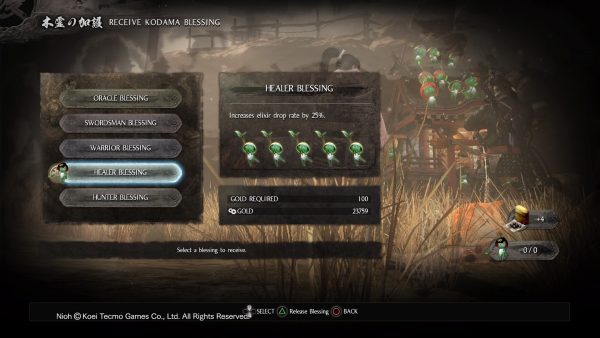
Find as many Kodama as possible, but learn how they work
Kodamas are the little green fellas that you see dancing at shrines. All main missions and some sub-missions have a number of them scattered around the level that you can find and send back to the shrine.
Before you head into a mission, you can find out how many are lost in the level that you need to bring back. You can also check how many you’ve got at any given point by selecting the Kodama Blessing menu at the shrine.
With each five Kodamas you find, your starting Elixir count is increased by one. There’s an upper limit, though. More importantly, the counter is region-specific, and will reset once you head into a new region. It's a good idea to track down new Kodamas whenever you hit a new area, so you can build up your Elixir bank as soon as possible.
Some gear items have a bonus that highlights Kodamas on your minimap. It can be useful to equip said gear when you're hunting for that one last sucker.

Certain passive skills in the skill trees of other weapons also apply to your own
There are certain passive skills that you can benefit from, even if you don’t use the weapon they’re attached to.
For instance, if you main two-handed swords, you can still take advantage of the Tachi Arts skill in the dual swords skill tree. The list of skills that work universally is too big to mention here, but you should definitely have a look at passive skills for each of the weapons’ trees to see if there’s anything you can use.
The Ninja and Onmyo trees are a fair game, too, so pick of these as many as you can afford – regardless of your main weapon of choice.
It's amazing how far you can pad out your build with useful passives by turning your attention further than your favourite weapon and upgrade tree.
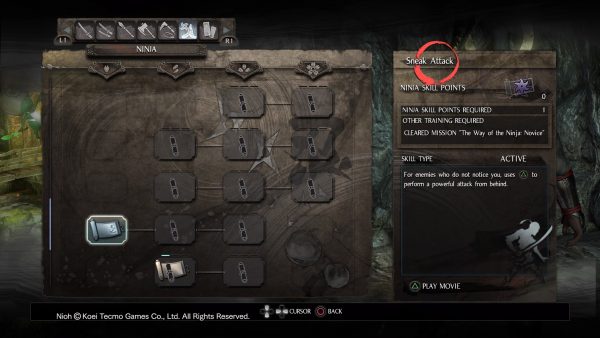
Unlock the Sneak Attack skill to be able to backstab enemies
Here’s an example of a very, very useful skill you can use with any class that happens to fall under the Ninja skill tree. If you played a Soulsborne game before, you’ll know that sneaking up on enemies and backstabbing them is a great way to do free damage.
In Nioh, you’ll need to first unlock the skill under the Ninja skill tree. Although it’s not as powerful as it is in Souls, it’s still a good way to get some decent damage done before the fight starts. It may not be fair, but it's very effective.
Same Souls rules apply here, too, so approach your target slowly from the back. Then, you’ll want to lock on and wait for the icon to turn red, only then can you press Triangle to do the move.
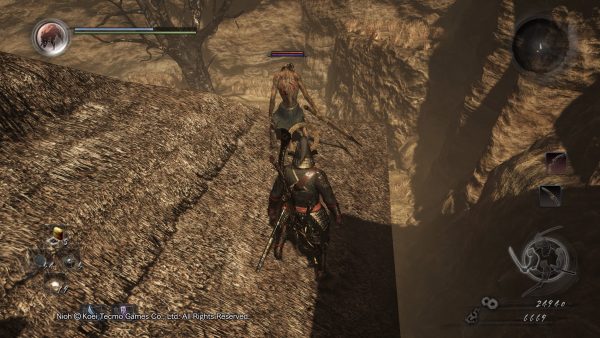
Always make note of the colour of the lock-on icon
If you're struggling to land grapples, ground stab and other context sensitive attacks in Nioh, that's because these moves can only be performed during a short window, and it doesn't always line up with your expectations.
You can identify the window for these moves very easily, though: watch for the lock-on icon turning red. This indicates that you can perform these types of moves, such as the Sneak Attack, the Grapple move for enemies out of stamina, and so on.
If you ignore this and go for the attack while the icon is white, William will not be able to perform the move, and you’ll just stand around like a burk, probably shouting at the controller.
Some enemies take longer than others for the icon to change into red, depending on their animations, so be patient.

Spirit Stones also charge your Living Weapon
Spirit Stones are the equivalent of the Souls you find in the Souls games (soul of a brave warrior etc). They have a similar function here, namely, they give you Amrita in different amounts depending on the size of the stone.
But there’s one more use for them in Nioh: these stones also allow you charge up a certain amount of your Living Weapon. This is very helpful when you’re doing a boss run and don’t want to engage enemies on the way to recharge the Living Weapon.
What’s more, 500 Amrita Spirit Stones will also charge a Living Weapon decently, and you no doubt have plenty of those. A pretty inexpensive way to skip past grunt enemies,

On boss runs, call back your Guardian Spirit at the shrine
Another tip when banging your head against a boss is to call back your Guardian Spirit when you respawn rather than retrieving it at the boss arena for the Amrita it is carrying. This can be helpful in two ways.
First, if you recall it at the shrine and proceed to fight a few enemies on the way to the boss, you’ll be going into the fight with a partially charged-up Living Weapon, which will make fully charging it during the fight easier, so you can eventually use it against the boss.
Secondly, if you don’t want to waste time on mobs on your way to the boss, you can use the Spirit Stones like we mentioned to speed up the charging process. Either way, you really don’t need whatever Amrita the Guardian was protecting inside the boss room, so always call it back at the shrine in these situations.
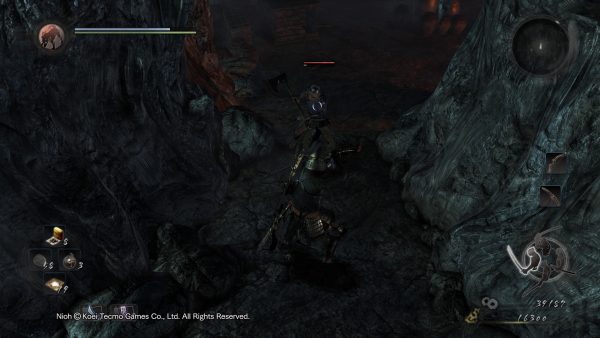
Don’t dodge away if you get caught up in an enemy's attack combo: block instead
I am sure you’ve already come across the Hino-enma boss fight, and I can guess you’ve been caught into her three and four-hit combos a few times, too. The same can be said for any of the big Yokai enemies, whose multiple-hit combos are inescapable.
The issue here is that if one of these hits land, you won’t be able to dodge and avoid the rest of the combo. You can dodge away before any hits land, sure, but if you get hit once, dodging the rest won’t work.
What you can do, however, is to block the rest of the combo. You’re either going to weather the storm and lose some Ki, or break their combo. I know it can be hard to not always mash on dodge as a defence mechanism (especially coming from Souls), but you really must remember to block when you get caught in a combo.
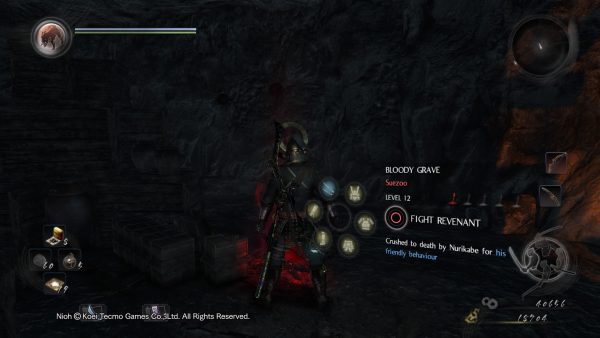
You can find out why other players died where they died - use that
Dead players’ graves can help you in different ways. If you approach any of them, the reason for their deaths will pop up.
It’s not an animated phantom like in the Souls games, but rather a written description of what caused their demise. Sometimes you'll come across certain suspicious spots filled with player graves, which usually indicates there’s a trap or ambush ahead.
Without reading their cause of death, you won’t find out what you need to be ready for.
Outside of that, the revenants that spawn from these graves can drop some of the gear these players were using, and fighting them is generally a good way to hone your skills, since they use human-like tactics in the fight.

You can make the Nurikabe (walls with eyes) disappear without having to fight them
Certain levels have Nurikabe - illusory walls with eyes that will light up when you approach them. Though your first instinct may be to smash them, don’t.
They’re tough to fight, and there’s a chance you can reason with them instead. You can make them disappear by doing one of your gestures, but knowing which one to use is the trick.
You’ll notice that your gestures menu (accessible by pressing Options by default), divides the available gestures into three different groups: Yellow, Blue, and finally Red.
It doesn’t matter which gesture you use, so long as you’re using one that belongs to the right colour. Each of these walls are different, so there’s no way of knowing for sure the colour each one wants, but you can make your guesswork a bit easier.
If you examine the player graves around these walls, they will sometimes tell you which gesture group the player tried that got them killed. So if, say, a player used a gesture from the Blue group that resulted in the Nurikabe attacking him, you’ll know to avoid using Blue gestures with this particular wall.
Now, all that’s left to do is try one from the Yellow group, and another from the Red group. Any gesture will do, and since we’ve already ruled out the Blue stuff, either Yellow or Red has to work. You can get it wrong the first time, in which case the wall’s eyes will turn red.
Get it wrong a second time, and they will attack you. Get it right, and they’ll be gone.
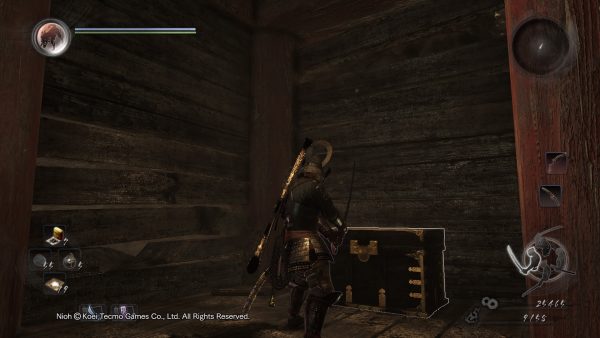
There are mimics in Nioh, and you don’t have to fight them for the loot
Mimics, or traps that take the appearance of chests to lure unsuspecting players, can be found in Nioh. They’re not as plentiful as in Souls, but they are there.
The easiest way to identify a mimic is to count the number of golden stripes on the chest itself (see above). Two stripes is safe, and three stripes is trouble. If you open a mimic without realising it is one, an enemy that resembles you will jump out and do a gesture.
If you’re able to match his gesture, they'll become happy and leave you some loot. Note that you must use the exact gesture, not the colour group business. If you use the wrong gesture, they'll become hostile.
There’s another thing you can do, too, if you correctly identify a chest as being a mimic before opening it. Simply use the whistle gesture to get the mimic to pop out of the chest. You can then proceed to copy its gestures in order to obtain its loot.

Refashioning is how you can maintain a dapper look without breaking your build
The blacksmith Tome offers a number of crucial services that you should familiarise yourself with as early as possible. One of these is called Refashion, which is basically Diablo and WoW’s transmogrification.
Simply put, Refashion allows you to change the appearance of any of your weapons and armour into that of another. For instance, you can rock the London Tower Guard outfit without having to use that armour set.
This only changes the look, so your actual piece’s stats will remain the same. This is great if you’re going for a specific style and don’t want to sacrifice your gear for it. The process is cheap, too, and the more items you find in the world, the more looks you can change into.
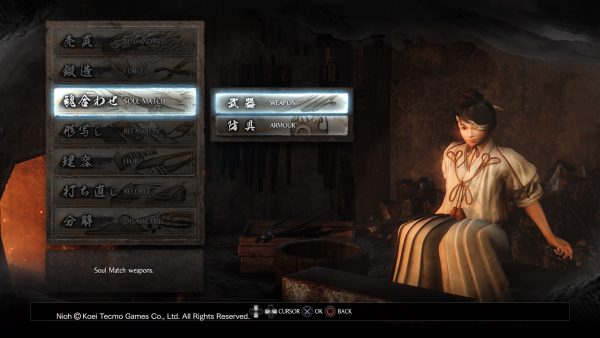
Don’t rely too much on Soul Match early on, it gets very expensive
Soul Matching is another great thing the blacksmith can do. Soul Matching is basically infusion from Destiny - feeding gear into other gear to make it better.
Because Nioh throws more loot at you than you can handle, it’s sometimes best to stick with what you have and Soul Match it with other higher-level stuff to gain its power, instead of equipping the new stuff right away.
Beware, though, this process is very expensive, and if you Soul Match every piece of gear you have equipped, you’ll be bankrupt in no time. Instead, only Soul Match items you’re really attached to, or ones with great bonuses, such as set items.
Later on, when money isn't as much of an issue, you can Soul Match more often.

Spend your Prestige Points and Tome patronage points
Every time you unlock a new title, which you'll do by simply playing the game and performing certain actions multiple times, you also earn something called Prestige Points.
These points can be spent in four different categories, granting you permanent boosts to certain skills and attributes. Head to the Titles screen and look for the Prestige section. From there, you'll be able to spend the points you have in the different categories and enjoy the boost.
As for the blacksmith, the more you do business with Tome, the more discounts and other perks she'll offer you. After spending some of your cash at her store, simply click Dialogue, and go to I Have a Request for Tome to see if you've earned enough of her favour to get a sweet deal.

Use Himorogi Fragment and Himorogi Branches to return to the region map
If you've found yourself on the wrong side of a one-way drop and can't face what lies beyond, or are just tired to trek back to a shrine, you can sacrifice the Amrita you're carrying and warp back to the world map with the Himorogi Fragment item. Phew! You can keep whatever items you've found without having to face death or dishonour, or leave your corpse miles out of your way.
Since you lose all your currency this isn't necessarily ideal, so keep an eye out later in the game for Himorogi Branches. Although these consumables are in limited supply, they'll get you back to the map with all that precious Amrita still in your pockets. Ideal.
